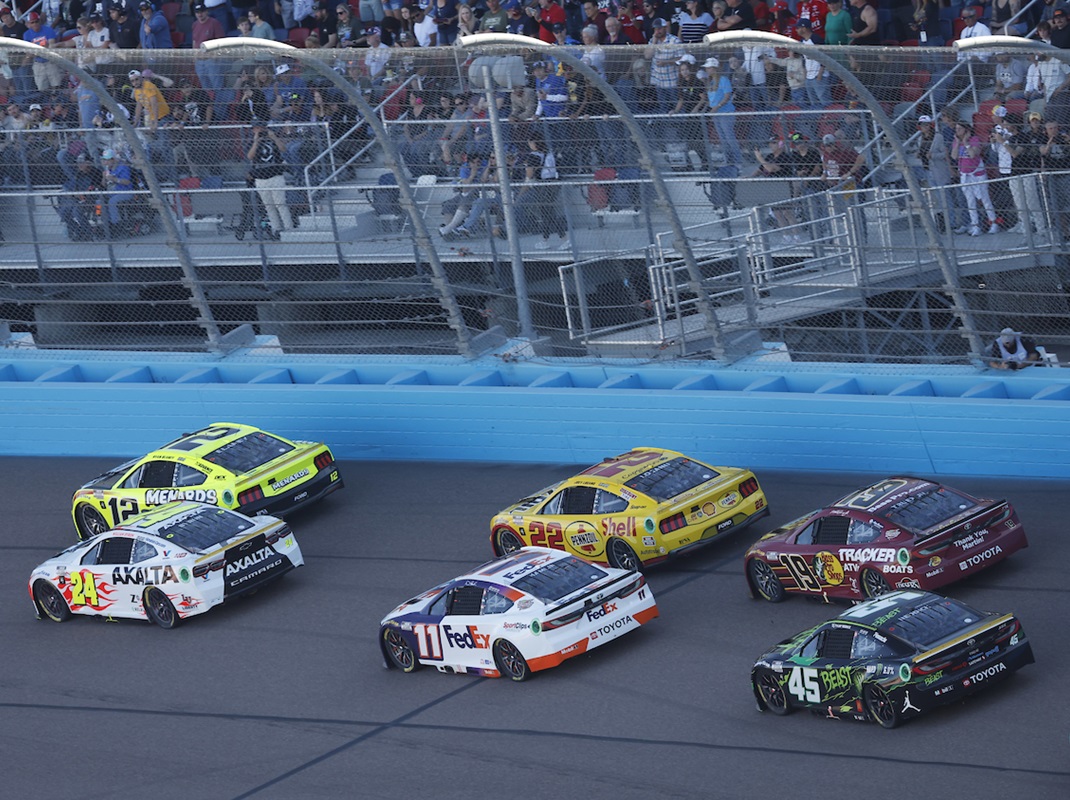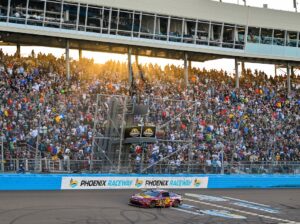OPINION: Fifth Time’s The Charm For Phoenix Finale

Phoenix Raceway played host to NASCAR Championship Weekend for the fifth time this year. (HHP/Andrew Coppley photo)
AVONDALE, Ariz. – Another NASCAR Championship Weekend has come and gone at Phoenix Raceway, and this marked the first time it really felt as if the one-mile track was fully embraced as the home of the sport’s finale.
From the time the title contenders across NASCAR’s three national series fielded questions at Media Day on Thursday, until the moment that Joey Logano hoisted his third Bill France Cup on Sunday, there was an undeniable electricity charging the atmosphere at the state-of-the-art facility.
To provide a little background, I’ve been going to Phoenix since 2008. In the 16 years since then, I’ve yet to miss a race weekend. Although my family and I stopped camping at the track in 2017, I consider that place to be my second home and the grounds that raised me.
During that span, I’ve witnessed some of the most memorable moments in NASCAR history, as well as a $178 million transformation that rivals some of the best venues across professional sports.
Courtesy of a deeply rooted history dating back to 1964 and recent world-class renovations, I’ve seen my home track go from being the penultimate race of the season to being awarded the honors of hosting NASCAR Championship Weekend.
And as Phoenix Raceway put a capper on its 60th-anniversary season, it seemed only fitting its fifth year as the site of the finale could be deemed its most successful yet.
The NASCAR Cup Series Championship Race marked the seventh consecutive sell-out crowd at Phoenix, but it also felt like this was the first time it truly felt like a crown-jewel event.
Since being named the site of the sport’s finale in 2020, it dealt with the adversity of having to overcome the in-person restrictions and apprehensions of COVID-19 – hence why the track’s streak of selling out on Sundays only dates back to the 2021 finale.
Getting back to what makes Phoenix a perfect host for championship weekend – and what made 2024 its most successful term yet – I’m going to begin with the basics.
To state the obvious, Arizona is renowned for its near-perfect year-round weather. Its notorious warmth, accompanied by the sight of picturesque desert landscapes, has established the Grand Canyon State as a destination spot for decades. This is one reason why Phoenix is one of the largest-growing cities in the United States.
Typically, temperatures approach around 90 degrees on both the March and November race weekends, to where you’re still breaking a bit of a sweat in the sun. This championship weekend, the weather couldn’t have been better. With highs averaging in the low 80s, this was by far the “coolest” and most comfortable I’ve personally felt over the last five years since Phoenix became the finale venue.
In my opinion, energy is the biggest variable when determining the worth of a championship-caliber event, and you get that as soon as you pull up to Phoenix Raceway. Ever since the renovations, every time my car rolls over the bridge and the track comes into view, the “Jurassic Park” theme plays in my head the same as when Dr. Alan Grant sees real dinosaurs for the first time.
It’s a silly simile, but without fail, that is the exact sense of euphoria and disbelief I’m in each time I see the one-mile track come into view. Sitting at the base of the Estrella Mountains, the towering, naturally-formed hills encase the open-facing facility, giving off the illusion of a coliseum while also setting the tone for a battle amongst gladiators in front of arguably the best views in all of NASCAR.
From a fan perspective, the infield experience is second to none at Phoenix Raceway. Since the renovations, which prioritized the fan experience, spectators have more access than any other track on the circuit. The only other venues that come close to matching what Phoenix brings to the table are Las Vegas (Nev.) Motor Speedway with its Neon Garage and historic Daytona (Fla.) Int’l Speedway.
At Phoenix, fans enter the infield through the tunnel of champions, where plaques of previous winners at the one-mile track line the walls. Inside the belly of the beast, everyone has access to victory lane and is within arms length of teams working on their cars in the garage. Another really cool perk is being able to catch drivers entering and exiting the media center.
In addition to the access, there are tons of options for concessions, lounge areas and even souvenir shopping. That’s not even accounting for the ability to walk up and down pit road with the proper credentials or tickets.
The last thing I’ll hit on as a segway into the most recent championship weekend is the fan midway. I’ll admit, over the past nearly 10 years, there wasn’t a whole lot to do outside of visiting the merchandise haulers, grabbing concessions and hitting the few sponsor activations available on site.
Since Sprint left NASCAR as a title sponsor, this experience took a massive hit for whatever reason, leaving the racing and infield access as the only real selling points for fans at Phoenix.
This year was the first time since the early 2010s it felt like there were so many options for fans who weren’t fortunate enough to snag infield passes. Sure, there were the merch haulers, but this time around there were a seemingly infinite amount of sponsor vendors, with interactive games and driver appearances and an insane number of options for food and drinks.

A sold-out crowd watches Martin Truex Jr. in action at Phoenix Raceway. (HHP/Jacy Norgaard photo)
Earlier, I mentioned energy and atmosphere as a huge part in determining the worth of hosting a championship. Between the midway and the infield, this was by far and away the largest and most enthusiastic crowd I’ve seen at Phoenix since it started hosting the championship, and probably since I’ve been coming to this place back in 2008.
Walking the midway, assessing the infield and taking in all sights and sounds on the final Sunday of the season, this was the first time this felt like a true championship event at Phoenix. It’s difficult to properly articulate exactly how it felt leading up to the green flag, but the buzz radiating through the air was something special.
When talking about Phoenix as the site of championship weekend, the area it’s most criticized for is the reason people show up: the racing. This is one area I feel I may not be the best at getting a read on for the fan experience, seeing as I’m cooped up in the media center for its duration.
As someone who covers the sport, I’ve always felt this was a perfect track for crowning a worthy champion, due to the technicality of mastering it.
With that said, I know teams and drivers trying to overcome the challenges of Phoenix doesn’t equate to something that’s always compelling to watch for the casual fan. For someone buried in his laptop, glued to the monitors and listening to the scanners, I’ve never had an issue with the racing at Phoenix.
The tired saying is “you can’t pass at Phoenix” in the Cup Series. This past spring, 2,800-plus green-flag passes were the most with the current car at the one-mile track, while the finale had the second-most with over 2,700. Technically, you can pass at this track and it is more than other short tracks on the circuit, but again, that doesn’t mean it’s always pretty to watch.
The main issue here is the lack of perceived competitiveness in the Cup Series with this current car. I will admit that. However, if you look at the NASCAR Xfinity and Craftsman Truck Series championships over the years, the racing at Phoenix for the finale has been phenomenal.
The sanctioning body has tried to fix the racing for the top level with annual tires tests and rules package modifications with definite gains, but not nearly enough to keep fans watching at home satisfied.
It’s hard to dispute those who say Homestead-Miami (Fla.) Speedway is the better place from a racing perspective to crown a champion, but for better and for worse, it’s not Phoenix Raceway.
Homestead isn’t selling out seven consecutive races, and it certainly doesn’t come close to matching the state-of-the-art amenities the one-mile track provides, along with drop-dead gorgeous scenery and an unrivaled fan experience.
There’s a reason why Phoenix has sold out seven straight Cup races. There’s a reason why people from all 50 states and multiple countries made the trip out to this year’s finale.
Yes, it’s where NASCAR crowns a champion, but Phoenix as a whole really does provide an unbelievable experience that needs to be taken in to be truly appreciated.
The opinions expressed are those of the writer and do not necessarily reflect those of Race Face Brand Development, Race Face Media, their staff, partners, or other subsidiaries.
